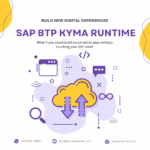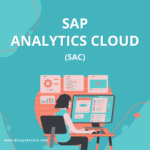We’re constantly told that data is the new oil.
But in reality, data is more like crude oil—useless until refined, connected, and acted upon.
Businesses don’t struggle because they don’t have enough data. They struggle because their data is scattered across silos, unstructured, redundant, and often… outdated. That’s where SAP Data Intelligence (DI) enters the picture—not just as another tool in the enterprise tech stack, but as a central nervous system for managing data pipelines across diverse landscapes.
In this blog, we’ll take a real-world approach to SAP Data Intelligence:
- What it actually is
- Where it fits in the SAP BTP ecosystem
- How it solves modern data challenges
- And how you can get started, without the jargon
What Is SAP Data Intelligence?
At its core, SAP Data Intelligence is an enterprise data orchestration tool.
It’s not a storage solution. It’s not just an ETL engine. And it’s definitely not just another dashboarding product.
SAP DI connects all your data sources—cloud, on-premise, structured, unstructured—and enables you to govern, manage, and orchestrate them from a single environment.
Think of it like the “data air traffic control” for your enterprise. It doesn’t care if your plane (data) is coming from AWS, SAP HANA, Snowflake, or a spreadsheet. Its job is to make sure they all arrive at the right terminal, at the right time, for the right purpose.
The Real-World Problem: A Mess of Data Pipes
Let’s talk about reality for a second.
Imagine a retail company with:
- Customer data in Salesforce
- Product inventory in SAP S/4HANA
- Marketing data in HubSpot
- Analytics in Power BI
- Legacy data still sitting in an on-premise Oracle server
Now, leadership wants a 360-degree customer view to personalize offers in real-time.
This is where the chaos begins. These systems don’t “talk” to each other natively. And trying to sync them manually is a developer’s nightmare. What you get is:
- Multiple teams working in silos
- Constant batch processing delays
- No single source of truth
- Errors in reporting
SAP Data Intelligence fixes this—not by replacing any system, but by becoming the connective tissue.
What Makes SAP Data Intelligence Stand Out?
- Hybrid Data Integration
- Supports connections to over 250+ sources, including non-SAP
- Whether your data lives on-premise or in the cloud, SAP DI finds it
- Machine Learning Integration
- Build ML pipelines using Jupyter notebooks directly within DI
- Operationalize your models in production without jumping across tools
- Metadata and Lineage Tracking
- Every transformation, every data movement, every anomaly—logged and visible
- Compliance and auditing become effortless
- Data Governance, Built-in
- Roles, access control, quality rules
- Integrates with SAP Information Steward and other governance tools
Use Case: Predictive Maintenance in Manufacturing
A real example.
A manufacturing firm uses:
- IoT sensors for real-time equipment data
- SAP S/4HANA for asset management
- Azure for ML model training
Problem: Sensor data lives in AWS, asset info in SAP, and predictions happen in Azure. Teams are flying blind without a way to stitch these pipelines together.
With SAP Data Intelligence, they:
- Connected sensor streams to SAP via DI pipelines
- Cleaned and transformed data before feeding into Azure ML
- Fed predictions back into SAP S/4HANA to automate maintenance workflows
Result?
- Downtime reduced by 40%
- Maintenance costs cut by 25%
- Decisions moved from reactive to proactive
Why SAP Data Intelligence Fits Perfectly in SAP BTP
SAP BTP (Business Technology Platform) is about agility, integration, and innovation.
SAP DI aligns with this by:
- Acting as the data layer for SAP BTP applications
- Enabling cross-application orchestration with SAP Integration Suite
- Supporting event-driven architectures via Event Mesh
If BTP is the ecosystem, SAP DI is the circulatory system. It keeps everything connected and flowing smoothly.
Getting Started: No, You Don’t Need a Data Scientist Army
Here’s a starter roadmap:
- Define the business case: What’s the outcome you’re aiming for? (E.g., better reporting, real-time sync, machine learning)
- Identify your sources: List all systems, structured and unstructured
- Build pilot pipelines: Start small—maybe syncing two critical systems
- Automate & govern: Once stable, add monitoring, quality checks, access rules
- Scale: Expand pipelines, integrate ML, build self-service data catalogs
Tools you’ll use inside SAP DI:
- Modeler: drag-and-drop pipelines
- Metadata Explorer: for data profiling
- JupyterLab: for custom logic and ML
The Shift in Mindset
Let’s borrow a page from Simon Sinek: start with why.
Most data projects start with what tools to use. But successful ones start with why—why does this matter to your business?
When you think of SAP Data Intelligence, don’t think of it as a tool. Think of it as a mindset shift:
- From reactive data usage to proactive orchestration
- From IT-centric architecture to cross-functional usability
- From siloed insight to enterprise-wide clarity
Because at the end of the day, intelligence isn’t about dashboards. It’s about clarity, speed, and connection.
Conclusion: Data Alone Isn’t Enough
Businesses are swimming in data—but few know how to make it flow.
SAP Data Intelligence doesn’t give you more data. It gives you better context, faster pipelines, and a single view of what’s actually happening in your organization.
And when your data flows, so does your business.











